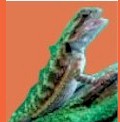Have you ever wanted to talk to your pet lizard? Maybe you already do. How about understanding what he is saying back to you? Beardies, like many animals, have a very distinctive way of communicating, which you can learn to understand. This gives you a better way of understanding how happy your Beardie is and how it feels about you!
Head BobbingBoth males and females bob their heads from time to time. They nod their head rather quickly up and down, almost as if they are dancing. This signifies dominance, especially when accompanied by a puffed out or darkened beard. It is common for beardies that are housed together to do this as well as when they see their reflection. Some bearded dragons may do it to things outside their tank, including you! Occasionally Beardies will bob their head to show displeasure, if they are stressed or they have been put back in their enclosure they will bob their heads to show they are unhappy about it!
NoddingNodding, unlike bobbing, is just a quick flick of the head. It can be hard to spot and is mostly done by adults, males mostly. Bearded dragons nod their head toward other bearded dragons to show they realize they are less dominant and that they are being passive. If you Beardie nods to you, he is showing he is passive toward you.
Bowing DownSome beardies, mainly young adults, will bow down low. Usually with their head, slowly and remaining in the position for a while. It is most commonly seen when beardies are kept together and after a dominant one has done a head bob or two. It is showing a similar thing to nodding but in a much more obvious way. Females are often seen doing this in order to submit to a male although younger males will also do it to more dominant adults.
WavingOccasionally, your Beardie might hop from one front foot to the other, whilst slowly waving the held foot around. It is seen mostly in young bearded dragons and very, very rarely in adult females. It is a form of submission, but rather than submitting it is more of an acknowledgement of dominance and means, "let's not fight - let's be friends!"
Beard PuffingThis is sometimes just something they do, particularly in the morning to warm up. Sometimes it will accompany head bobbing, which is a display of dominance. Other times, if it suddenly puffs out, accompanied with gaping, it can be fright or nervousness and shows that it feels threatened.
Open WideGaping the mouth open wide can mean a few things in beardies. In younger specimens it is simply the way they regulate temperature. When accompanied by puffing of the beard or darkening of the color it means that they are scared or intimidated. In extreme cases they may slowly tip their head back and darken in color, puff out the beard, twist and broaden and emit a hiss, this shows an extreme fear reaction.
Color DarkeningThe beard on a bearded dragon is capable of turning jet black, or at least a very darker color. This is often very rapid and can mean different things depending on the behavior accompanying it. For example, darkening in dominance displays shows dislike and that the Beardie is trying to intimidate his opponent. When accompanied by gaping or broadening it shows dislike or even fear. If your Beardie is always darkened or has a dull or dark appearance then it may be stressed and usually this down to the temperature gradients not being correct.
Body FlatteningBeardies generally flatten their bodies to show displeasure. Sometimes they will do it in unfamiliar situations and other times they will do it to try and intimidate another Beardie. It is often accompanied by Beard puffing and tail gestures to warn off the threat or other Beardie. Occasionally males will do this while circling each other, this is an extreme display of dominance, usually where neither will back down. You should separate beardies that do this, as they will fight.
Curling TailCurling the tail is usually a concentration thing and will be seen by all ages, usually around feeding times. They tend to do it before the strike, meaning it is more of a balance orientated thing rather than a gesture.
Raised TailOccasionally seen in males as a defensive stance, showing they feel threatened or are ready to fight. It is more often seen in females who are being submissive to males, usually when they are ready to breed.
Waving TailWhen the tip waves slowly this is usually indication of an annoyance. Sometimes done in females who are submitting but are not happy with it. With males it can be used as "defeat" signal but that the Beardie is ready to challenge the dominant one again. All beardies may be seen doing this at feeding time where it denotes a concentration.
